#Dublin Brigade IRA
Text
#OTD in 1923 – Noel Lemass, Anti-Treaty IRA officer in Dublin, brother of Seán Lemass is abducted by Free State plainclothesmen and killed.
‘The Winter Sleep of Captain Lemass’
by Harry Clifton
The life of the country
Hardened against you
Like frost, and a new front
Opened—brother against brother,
Choice against choice,
Disputing the high ground. Your eyes,
Blindfolded, beheld the ideal State
As the real one steadied itself
To annihilate you.
How to survive it, the force of exclusion,
The freezing out of the soul
At the site of its…

View On WordPress
#1916 Easter Rising#3rd Battalion#Dublin Brigade IRA#England#Free Staters#History of Ireland#Ireland#Irish Civil War#Irish War of Independence#Murdered#Noel Lemass#Seán Lemass#Wicklow Mountains
10 notes
·
View notes
Text
sounds familiar, wouldn't you say? Israel is just an extension of british imperial rule and it acts exactly like it. full credit to @/davy_holden on instagram
transcription under read more
full text: "If there is one quote that sums up the Irish war of independence, then I think it's this one by colonel Gerald Brice Smyth. Colonel Brice Smyth was the commissioner in charge of the police and the military in Munster, and let's not forget that Munster was the most dangerous part of Ireland during the war of independence. Here's the quote: "Police and Military will patrol the roads at least five nights per week. When civilians are seen approaching shout 'hands up' . Should the order not be immediately obeyed, shoot them and shoot with effect. If the persons have their hands in their pockets or are in any way suspicious at all, shoot them down. You may make mistakes and innocent person may be shot. But you are bound to get the right person sometimes. The more you shoot, the better I will like you and I assure you that no policemen will get into trouble for shooting any man. Hunger strikers will be allowed to die in jail. The more the merrier. A ship will be leaving an Irish port in the near future with lots of Sinn Féiners on board, and I will assure you, that the ship will never land." (end quote) And this was essentially the british governments policy in Ireland during the war of independence. Little did Colonel Smyth know that one of the IRC men called Jeremiah Meed had recorded that speech and sent the speech to Dublin and one month later it was published in the Freeman's Journal. One week after that Colonel Smyth was spotted in a bar in county Cork and the waiter informed the IRA. Cork No. 1 Brigade arrived at the building and shot Colonel Smyth dead at the bar" End text.
1 note
·
View note
Text
IRA Burns Dublin Custom House

The Customs House on fire.
May 25 1921, Dublin--Fighting during the Irish War of Independence had so far been on a smaller scale: ambushes, assassinations, and the like. Éamon De Valera, President of the Dáil, pushed strongly for a higher-profile engagement, over Michael Collins' objections. At 1 PM on May 25, the IRA stormed the Custom House in Dublin and began making preparations to burn the building. However, before they could finish and evacuate the building, British Auxiliaries arrived and began firing at the IRA inside, who quickly set the building on fire. The IRA quickly ran out of ammunition and could not hold out for long in a burning building, and at least 80 IRA members were arrested. Fire brigades were also held up by the IRA and arrived too late to save the building, which burned to the ground. The Irish tried to claim the burning of the Custom House as a propaganda victory, but the capture of so many men was a serious blow.
This took place against the backdrop of the previous day's elections, called for in both Northern Ireland and Southern Ireland by the Government of Ireland Act 1920, which had first formalized the partition of the island. Apart from the four seats reserved for Trinity College, the Southern Irish seats were uncontested and swept by Sinn Féin, who would not take their seats in a parliament they had not agreed to and did not recognize. In the north, the Ulster Unionist Party (UUP) took two-thirds of the vote and three-quarters of the seats, with the remainder split between Sinn Féin and the remnants of the Irish Parliamentary Party. The Government of Ireland Act 1920 had not included all of Ulster to secure such a Unionist majority in the north, but had also included a large Catholic minority simply to give Northern Ireland a larger region on the map.
Sources include: Michael Hopkinson, The Irish War of Independence.
#wwi#ww1#ww1 history#ww1 centenary#ireland#world war 1#world war i#the first world war#world war one#dublin#de valera#may 1921#northern ireland#michael collins
29 notes
·
View notes
Text
The Celtic Tiger - A Kaiserreich Ireland AAR Chapter 2: An American Tragedy
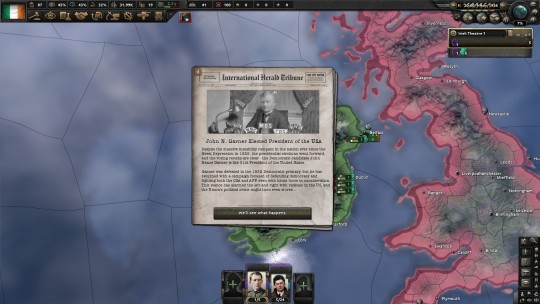
12 February 1937 - Home of Michael Collins, Cork, Ireland
“The United States of America has faced challenges since its founding, but it is an enduring republic. When we were invaded, we fought off our attackers. When the Great Storm hit Galveston, we built cottages from the storm lumber. When Black Monday reached our shores, we passed the Garner-Wagner Act to deliver our people relief. The American people, through this election, have made their will clear. They do not want the empty promises of Jack Reed. They demand more than the sayings of Huey Long. Words are not enough, action is required. That is what I shall promise: action. We will stand firm against the threat of populism and syndicalism.”
Benjamin Franklin, after the Constitutional Convention, was asked whether the United States was a democracy or a republic. His words were: ‘a republic, if you can keep it.’ That was not mere wit, but a charge; a sacred duty given to every citizen. Today we say: it is our republic, and we shall keep it.” -US President John Garner, Excerpt from Inaugural Address
In Michael Collins’s case, war never seemed to have a countdown, but sure enough, the war looked like it would begin in 30 days. Just the thing to ruin his vacation; he had hoped to spend a few days in Cork to recharge his batteries, and ended up having indigestion and headaches the entire trip.
The United States had been a roiling mass of discontent since 1925, but it had only gotten worse during Black Monday. President Garner had won a lot of support in his campaign, which had focused on trumpeting the successes of the Garner-Wagner Act and touting the President’s willingness to fight any who threatened democracy. “A snake is a snake is a snake,” Garner had been fond of quoting on the campaign trail, swaggering with a pair of revolvers. “I plan on working to fix the mess that we’ve found ourselves in. If Jack Reed and Huey Long want their voices heard, I’ll listen to them. If they want prosperity for America, they’ll listen to me. And if they want to fight, they’ll get one. I don’t plan on striking first, but as God is my witness, I’ll be striking last!”
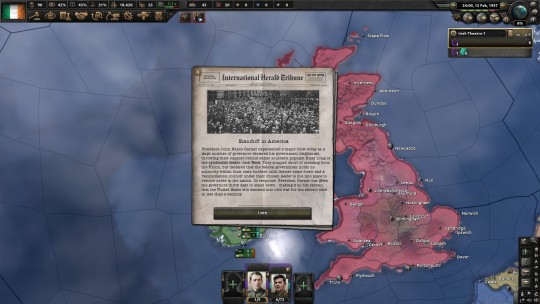
That had been enough for the Presidency. Jack Reed’s Socialist Party of America and Huey Long’s America First Party had strong regional support, but neither movement received enough votes to beat the Republican candidate Alf Landon, let alone Garner. Yet the victory was narrow, and both candidates claimed voting irregularities arranged at the polling places by supporters within the state voting commissions, along with other accusations of beatings and intimidation campaigns. Herbert Hoover endorsed Garner in a show of cross-party American solidarity, and Landon himself was a guest of honor at Garner’s inauguration. Garner had already promised the Republicans some Cabinet appointments in the hopes of building a coalition government strong enough to stop Long and Reed. It was an uphill battle; the 1936 voting season had been marred by political demonstrations turning violent, they had even called it the Red Summer, and now Long and Reed were railing against the legitimacy of the vote.
When the populists had made their accusations, the governors in their regional strongholds had backed Long and Reed. The populists, it seemed, had called President Garner’s bluff. The governors demanded a “national reconciliation council” under their talking head, and both had made it plain that the other would not be welcome on it, making it all but certain that war would come, and it would not be small. Jack Reed was popular in the Steel Belt and Huey Long had an almost religious appeal in Louisiana and in the rest of the Southern United States. Reed had much of the industrial heartland, but Long had far more pull among the military including high ranking officers. It wouldn’t be an easy fight, no matter what Texans had to say. In both ways, it was bad for the United States.
Collins had hoped it wouldn’t be war, but he was sure that it would be. If Jack Reed was able to successfully overthrow Garner, the Internationale would be emboldened. The Communards might still be reluctant to face Germany, given how large such a war would be, but Mosley would almost certainly want to snap up Ireland to carry forth syndicalist momentum. Anti-Irish rhetoric had only intensified in the months following Ireland’s meteoric 1936 rise, with Mosley claiming that Michael Collins had become “every inch the oppressive king he fought against.” Collins laughed when he was first told it, but as the days went on he seethed against the man, wishing he could have five minutes alone in a room with him. He was sure his sainted ma would not look fondly on him for beating on a man with a limp, but she’d forgive him.
When the reporters asked for a quote, Collins was sure to give them one. “Look at Mosley in the war. Gallivanting around in an aeroplane like war was just boys at camp, crashing trying to be a showboat. I suppose I must be kind, he tried to prove he was a brave man, I’m sure it’s not his fault he ran behind a desk before a year was out. That’s where he’s most comfortable, hiding and sipping his gin while he sends young boys to do the fighting and dying.”
Collins had a good laugh, but he made sure to tell his diplomatic service to make sure that Ireland would have plenty of friends on both sides of the Atlantic, just in case the Union tried anything. Laugh in public, but service your pistol in private.
---
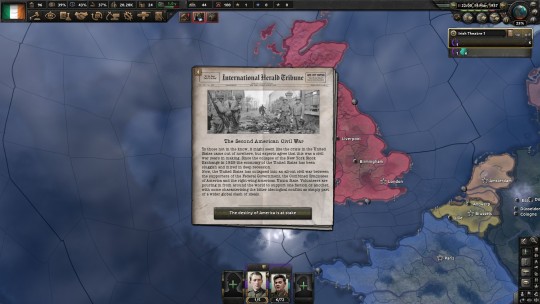
14 March 1937 - Áras an Uachtaráin, Dublin, Ireland
It was war. The entire world was aflutter with the news that the United States had descended into a civil war. President Garner’s deadline had come and went, and both Jack Reed and Huey Long had declared war on the United States. In response, Garner had appointed General George Marshall as Chief of Staff of the Army. The Internationale had already voiced its support for Jack Reed, with Chilean, Communard, and Union supporters already on their way to support the newly-formed Combined Syndicates of America. The German Empire was far more reserved in its support. German-Americans primarily lived in areas controlled by the Combined Syndicates, and the United States government had primarily conducted a pro-Entente policy during the Weltkrieg, leading the Kaiser to support Huey Long out of pure pragmatism. Canada had fallen into debate within the Houses of Parliament on who they were supporting.
Collins had no such reservations about debating who to support in the Dail. Collins had sent out a call for a volunteer division, the 1st Thunderbolts, and had placed them under the command of Daniel McKenna. The East Coast was dense with urban areas, and McKenna was just the man to fight in that difficult urban war, having fought the English in the cities before. The Thunderbolts had been training for months in preparation for the outbreak of hostilities. Most were young men, too young to have seen the Independence War, but their officers and senior NCO’s had. That would carry them, fighting in unfamiliar territory would mean they would have to adapt quickly and rely on the experience of the leaders. Other IRA volunteers, particularly those with families in the United States, had opted to go there themselves, fight in the American army, and return later.
The first target would have to be the syndicalists. With their position in the American industrial heartland, they’d have the manufacturing prowess and the civilian manpower to build and repair war materiel far faster than the mostly rural southern states. They would have to trust in their greater manpower and equipment to hold the southern front against the aggressive generals of the American Union State. The United States had begun mobilizing forces on the West Coast to get them to move east, and requisitioned several rail lines for exclusive military use, but it would be hard fought. America was going to need all the help it could get.
---
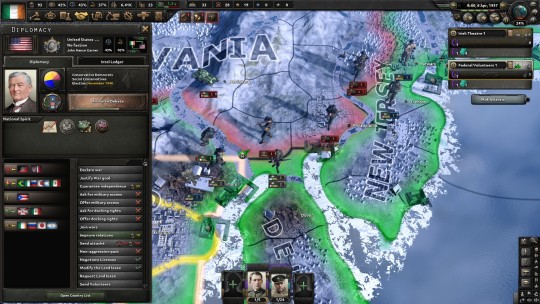
13 April 1937 - Northern Maryland, United States of America
“We have traitors to our left, and traitors to our right
Our Congress and our president have long since taken flight
No ammo, no armor, no pills, no cargo
No prayers, no chance, no hope of tomorrow
Just you and me and a hell of a lot of fight.” -Frank McHewlitt
Pennsylvania had become a battlefield for the Second American Civil War just as it had for the first. The Pennsylvania governor had declared for Jack Reed, but the Federals had made a march into central Pennsylvania, seizing York to Fulton counties, but lack of manpower, difficult terrain, and Communard volunteer tank brigades had ensured any excursion was short-lived. From New York to the Midwest was controlled by the Syndicalists. Fearing being overrun, Joseph Kennedy Sr. had asked Canada to send an occupation force to protect them from the Syndicalists. This had infuriated President Garner, but pragmatists in his Cabinet had argued that the region was indefensible since the Syndicalists held New York, and better that the Canadians occupy it, and the Combined Syndicates risk a war with the Entente, than the factories be taken over by Jack Reed. Further south, Canada had sent a force to occupy the Panama Canal after the Americans had withdrawn their garrison force. The Canadians had said their mission was to protect trade, but had banned ships flying Communard, Union, or Chilean flags.
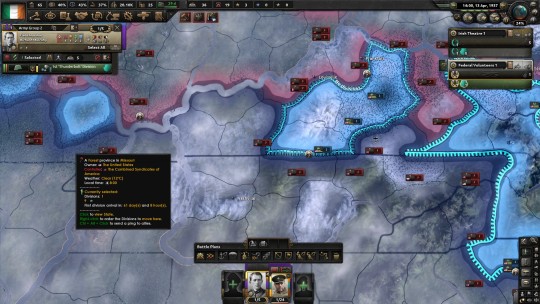
Further south, Texas to the Carolinas, and everything south, had pledged loyalty to Huey Long’s vision. Several companies had even signed on to the “Share Our Wealth” program. His men were heavily-armed and competently led, and they had already made significant inroads pushing north into Kentucky from Tennessee, even making contact with and fighting Jack Reed. George Patton had been named the overall commander of the American Union State, and on land the America First Party had shown themselves to be exceptional fighters pound-for-pound. Their goal had been to push and seize whatever territory they could, to turn the factories over to Longist control and get their war materiel production up to match the Federals and the Syndicalists. It had been remarkably successful, Patton’s armor techniques had run circles against disorganized Kentucky militia and revolutionary syndicalists alike. Already there were unconfirmed reports of mass shootings of CSA prisoners by AUS irregulars. The Federals were hard-pressed, often surrounded and potentially encircled by hostile forces in Kentucky. Only the chaos of the war and the close proximity of all three forces, kept them from being killed outright. Desertions, particularly from militia unfortunate enough to be in the encircled regions, were high.

Washington was no longer the capital. With Maryland under fire and the Firsters pushing from the south into Virginia, Garner had decided to temporarily move the capital to Denver, where he could oversee the political business of state. MacArthur had elected to remain in place as the commander of the East Coast Enclave, suggesting that Dwight Eisenhower take command of the main Federal forces in the Midwest. “He’s a Kansas man, there’s no man better in command from the Midwest. The troops will fight tougher and harder if they know we haven’t abandoned them. Don’t worry, Mr. President. Those bastard traitors won’t set a foot in D.C.” With his trademark corn cob pipe and a wave to the press, MacArthur took a ride on a Vultee V-1 to take up command, with Eisenhower being named the overall commander of Army Group West, with the goal of pushing east from Kansas into Missouri.
MacArthur welcomed the service of the volunteers sailing and landing on the Chesapeake, no traitor forces had been able to ensure naval supremacy on the East Coast and none were willing to risk firing upon a flagged vessel and invite any nation’s full-blown entrance into the conflict. Lavr Kornilov, eager to project strength and stability after the assassination of President Kerensky. Hirohito had also dispatched volunteers citing the strong relationship between the United States and Japan and the need for legitimate government to be re-established in the United States to project stability in the Americas. Calles in Argentina, eager to re-establish the Monroe Doctrine to act as a bulwark against the Patagonian Worker’s Front, and always eager to fight syndicalists. Brazil likewise had ordered troops to support the United States. Mexico, eager to avoid any war spilling over their borders, had closed the borders to the American Union State and had sent divisions through the Gulf of Mexico before the Longist navy could seize control of the waters and potentially cut off trade and transit. MacArthur ensured that each division had several bilingual Americans to serve as liaisons and communications personnel. He couldn’t command the volunteers, but he did demand adherence to military law and that any abuse of US civilians or military personnel would be dealt with by firing squad. Similarly, MacArthur promised his own men that they would be punished harshly if they stole from or fought with Federal volunteers. Regular correspondence was mandatory, and passwords changed regularly to allow foreign soldiers to identify themselves quickly to friendlies, passed via radio operators who had signed up with the Federals in record numbers when President Garner forced a bill and executive order expanding the civil rights of Native Americans to shore himself up for the upcoming emergency. The Navajo Nation, who provided one of the largest units, dispatched signals operators to coordinate with the volunteer brigades, providing exceptional communications security and coordination between the Federals on both fronts.
Yet things were not going well. MacArthur had enforced military law within the East Coast enclave, and garrison forces frequently looked to seize supplies and materiel for their war effort. Oftentimes, a token effort at compensation or promise of restitution to come later was the only balm in Gilead; it did not help those who starved.
The volunteer forces moved north to the Mason-Dixon line, where the Combined Syndicate militia were threatening to move south into Maryland from their regional headquarters in Philadelphia. The Russians opted to secure themselves in Baltimore, while the Argentine and Mexican forces moved to Cecil County to secure Delmarva from the syndicalists seizing the east bank and potentially cutting off vital access to the Chesapeake. McKenna and the Irish 1st Thunderbolt, acting aggressively, crossed into Pennsylvania and secured themselves in York. Not willing to pass up a fight, Russian and Irish volunteer brigades pushed into Lancaster County, threatening Philadelphia and forcing the Communards to reinforce their position lest Philadelphia fall and the road to New York be pushed wide open.
---
17 April 1937 - Economic Committee of the Dail, Dublin, Ireland
It had been a constant flurry of activity in the new year. The Dail was debating loosening immigration restrictions to help bring in new blood to help support Ireland’s effort to modernize. Even if good policy and hard work had led Ireland out of the depression following Black Monday, manpower was still the hard limit on everything they could do. Once unemployment fell, there would be no new employees for businesses, and they’d turn away from Irish investment.
There had been two major sources of pushback against immigration reform. The Unionists in Ulster had been vocal opponents, calling the efforts part of a planned demographic shift to stock the north with people that would sideline their concerns as Unionists. Their proposal had instead suggested an increase in immigration from select countries, notably Canada, Australasia, and the British Dominion of India. Gearóid Ó Cuinneagáin was far more hostile to immigration overall, demanding no immigration save from Celtic-majority countries, particularly those who wished to depart the Union of Britain from Scotland and Wales. Some of the measures proposed had truly been radical, such as instituting a Gaelic language entrance exam to new immigrants. The hAiséirghe crowd had always been a touchy subject, they had enough support in Munster that they couldn’t be ignored as much as Collins wanted to throw the bastards into the ocean.
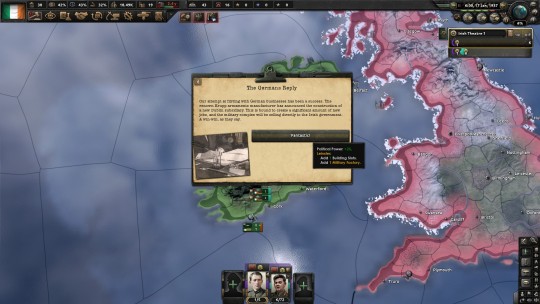
Collins had been lucky, his Dublin financial capital idea had already been receiving positive responses. The German Kaiserreich, still deep within the throes of Black Monday, had debated whether or not to permit German businesses to invest in Ireland. The protectionists in their government had argued that the last thing that they needed to do was open up subsidiary companies in Ireland and send work away from Germans. The market liberals were far more enthusiastic, suggesting that the profits made could be reinvested in Germany; an influx of cash that wouldn’t increase the money supply and devalue the Mark. In the end, Wilhelm II had agreed to the proposal. He had known that the Irish Republican Army had been looking to re-equip their forces, and Krupp could easily manufacture rifles and mortars with a sizable government contract. Krupp opened Krupp Rüstungsbetriebe Irland, redesigning the Krupp Radreifen into the shape of a shamrock.
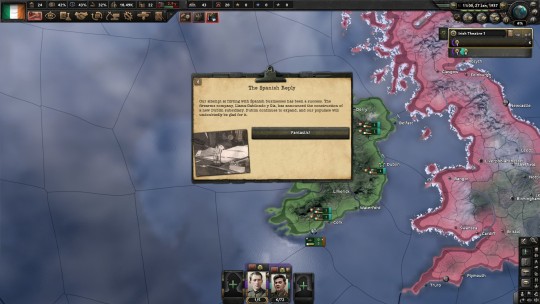
The Kingdom of Spain had also looked to establish an arms company in Ireland, eager to arm those who were also hostile to the syndicalists, and quite isolated on the European continent, with France and the German Protectorate of Morocco making an uneasy set of neighbors. Having a well-armed Irish Republic was a benefit to King Alfonso, who agreed to set up a subsidiary of Llama-Gabilondo y Cia SA, taking the name Dóiteáin-Gabilondo Incorporated, and selling their famous pistols to the Irish Republican Army. With regular army drills, and now a larger armaments industry within Ireland itself, a more significant and professional Irish Republican Army was starting to take shape.
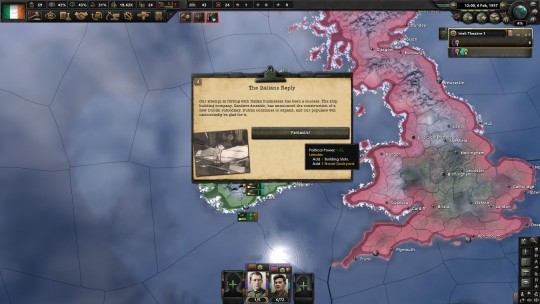
The Italian Republic, floundering in the wake of massive German and Austrian stock selloffs, were eager to find ways to bring in cash and stabilize their own economy. Seeing a pressing need, the Italian Republic opted to establish a naval manufacturing dockyard in Dublin as Gio Ansaldo Irish Sea Shipwright, Ltd, to help produce submarines for the Naval Service. Italian engineers could work in Ireland, the revenue would flow into Italy, and the Irish would receive a powerful deterrent against the Union of Britain’s navy. Working in the choppier northern waters was different from the warmer and calmer Mediterranean, but the Italians proved up to the challenge, christening the first Irish U-Boat the new Fenian Ram.
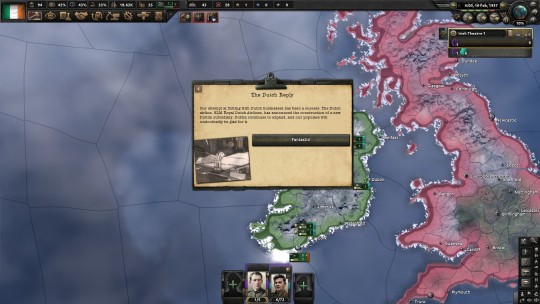
The rush of European activity to invest in Ireland had not gone unnoticed in the Netherlands. After a fierce and competitive bidding war, the Dutch government, very busy with their preparations for the upcoming elections in May, had given the go-ahead for Royal Dutch Airlines KLM to do business within Ireland. Rather than operating a strict subsidiary, as the government was still facing the worst of Black Monday, Royal Dutch instead opened a joint venture with Aer Lingus, operating a civilian airfield that would bring in much needed tax revenue, and providing expertise for the construction of a military airfield in Leinster. The Union of Britain had lodged a formal complaint against the move in the Netherlands, but the ambassador had been dismissed out of hand, the official response being “Ireland has a right to the sky, and Britain has no right to dictate policy to the Netherlands.”
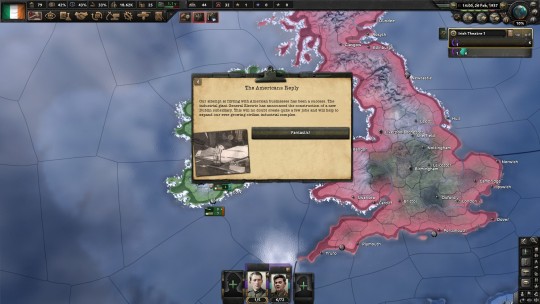
The United States had been considered highly unlikely to invest in Ireland. Even with the positive relationship that had existed between the two countries, the USA had been facing an existential crisis. To Collin’s great surprise, Garner had actually encouraged American companies to open subsidiaries in Ireland before hostilities broke out. In a diplomatic message to the Irish President, Garner had written: “I am certain there will be war. American industry will certainly not be spared. This initiative may save American lives and enrich both our countries. If the worst comes to pass, may God protect us both.” General Irish Electric, as the company titled itself, designed a logo incorporating the Irish harp in the signature “G” of the GE logo. The company received a grant from the National Industrial Investment Fund and purchased a factory abandoned during the Black Monday fallout, bringing up to speed in record time to produce civilian and industrial-grade electronics. Almost immediately, GIE had orders tasked almost to capacity for factories across Ireland to upgrade their own operations, throwing itself into the greater industrialization efforts that Michael Collins had championed the previous year.
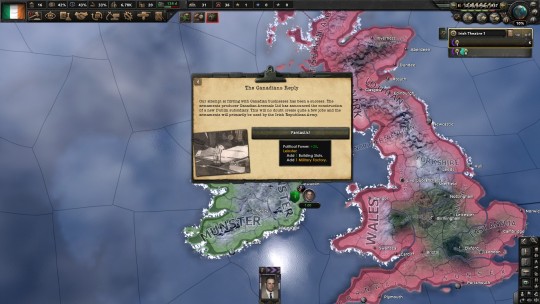
The Dominion of Canada was a much more difficult beast to wrangle. Edward VIII had made no secret that he wished to reacquire not just the British Home Isles, but the British Empire as well; he would not be a second-fiddle to the Kaiser. That would mean the Six Counties, surely, perhaps even re-establishing the Free State as a Dominion. Collins had debated even making the offer to Canada, but a good relationship with Canada was, putting Edward aside, a sound policy. Canada needed money to support their war efforts, and a friendly relationship with Ireland would mean less problems when launching their operation to take back the Home Islands. Collins privately feared that they would want to use Ireland as a staging ground. Ireland had situated itself as a prominent financial hub, and since Dublin was designated a Special Economic Zone, it could potentially be very lucrative and offer a way to sell to the rest of Mitteleuropa without dealing with the Kaiser. The Canadian government had assented to Canadian Arsenals, a crown corporation to open a subsidiary in Dublin named North Atlantic Arms. Collins made sure that it acted in all things as a private company, insisting that King Edward appoint an executive staff the same as any other business. That had been a headache in the Dail, with Eamon de Valera angrily demanding not to sell Irish land to King Edward. Collins had countered that Ireland was a free and independent republic, and that the King had to obey Irish law rather than dictating laws to Ireland.When rumors came around that Jim Larkin had supported Dev’s objections, the Fianna Fail politician withdrew his opposition in favor of a more moderate compromise, asking only that the Dail be presented the terms of the contract in open session so that they could vote on them. Dev’s desire not to give Larkin more ammunition had rapidly diminished opposition to the measure within Fianna Fail, and Sinn Fein offered only a token dissent, permitting the venture to go forward.
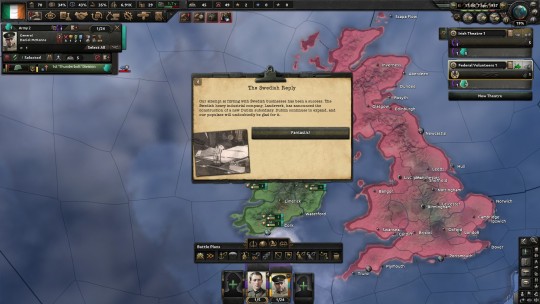
With the outbreak of war in the United States and Ireland’s rapid industrialization, Sweden had sensed an opportunity to open a subsidiary business in Ireland as well. AB Landsverk had originally sought to open a tank manufacturing plant, since the Irish tanks were largely outdated and the Irish Republican Army was going to need to modernize its arsenal. Fierce protest erupted from the social democrats within Sweden’s Parliament, opposing the idea of arming Ireland and facilitating a possible war between Ireland and the Union. The hawks within Sweden had supported the venture, but military arms, even support equipment, could not secure a large enough coalition for the Economic, Defense, and Foreign Ministers to agree to the venture. Not wanting to lose out on the potentially lucrative deal and already facing their own problems with syndicalist unrest, Sweden’s market liberals had offered a compromise within the Riksdag, allowing Landsverk to open Landsverk Inneal, specializing in tractors and harvesting equipment to support the modernization of the Irish agricultural sector. Several prominent military analysts noted that the new Inneal tractors, with a few modifications, looked suspiciously similar to a light tank with the turret removed, but these were dismissed as products of an overactive imagination by both Swedish and Irish military analysts.
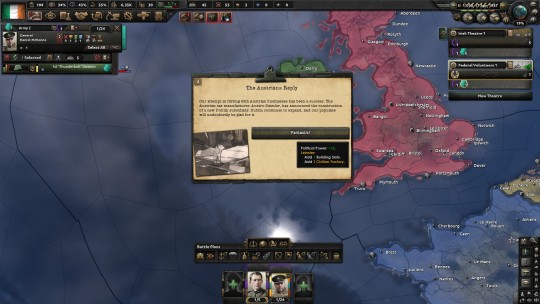
The Austrian Empire was in a difficult position in 1937. Emperor Karl I had been making significant plans for his Ausgleich Federation plans, and saw the Irish initiative not simply as a means to support his economy, but as a means to demonstrate both Austrian power and his willingness and initiative to support cooperation efforts for mutual gain. The Emperor had made his commitment to pluralism plain within his proposed federative model, he had hoped that participating in Collin’s economic initiative would help sway skeptics and naysayers to his side to give him greater support against Hungary. If it could help his economy and put neutral voters who cared more about their own personal livelihood than the greater plans of Austria-Hungary, that was fine as well. Daimler founded Irish-Daimler and focused on developing automobiles and lorries. While the Emperor could not be there in person, he had prepared a statement for the opening of the plant in Dublin. “Irish-Daimler is in the business of Irish business. Her success is our success, and our success is her success. May we both prosper in the days ahead.”
Eight nations had opted to do business with Ireland in such a short period of time, and there had already been murmurs for other nations to do likewise. The success of Irish Black Monday reforms had been the talk of the European financial sector. Even distant Japan had expressed an interest in perhaps opening a branch of one of their zaibatsus in Ireland to sell to Western markets, though such a discussion was in the planning stages. When interviewed by The Financial Times, Lemass had made the quote that had made the headlines. “Ireland is the Emerald Isle. She always sparkled in our hearts, now everyone can see it.”
When Michael Collins had heard that, he smiled. The man had the head of a businessman but the heart of a poet. The head and the heart needed to complement each other if he wanted to see Ireland through.
---
8 May 1937 - Áras an Uachtaráin, Dublin, Ireland
As the war passed into its third month, Collins started to wonder about the upcoming elections in the fall. America had been on his mind a lot lately. An emergency act by the Oirechtas called the Díodean initiative had allowed Americans seeking refuge to come to Ireland, and plenty had taken Collins up on his offer. Many immigrants came with much of their wealth with them, which had provided an influx of capital. Even more valuable, however, was the technical knowledge. Many of the immigrants had been factory managers or entrepreneurs, and they had knowledge which made them highly valuable in the industrial sector. Not every tale was so fortunate, however. Some culture shock was perhaps inevitable, but it had been incredibly slow going. Collins had remembered the first time he saw a new settler to Ireland drive on the wrong side of the road and cause a car accident. This felt like seeing that unfold in slow motion on a national scale. The poor Americans had felt the Irish were cheating them out of wages and exploiting their desperate circumstances, while the wealthy felt their standard of living drop precipitously.
The hAiséirghe crowd again troubled him. Reports of nativist gang uprisings in the poorer parts of cities and rural areas were on the rise. There were demonstrations that the new arrivals were stealing all of the good-paying jobs; this had been going on since the new immigration reform but now was reaching a fever pitch. The Unionists again rallied against Collins, accusing him of colonizing the north with people opposed to King Edward under the guise of humanitarian aid to defeat the Ulster Unionists at the ballot box. They demanded a series of refugee and work permits that did not confer voting rights as opposed to outright immigration and naturalization. That had caused a firestorm on the debate floor, causing no shortage of headaches for Collins.
To alleviate the shortages, Collins had organized refugee brigades in the Republican Army, where young men could earn a wage and provide a livelihood for their families. The Yanks were excellent shots, and Collins had hoped that seeing immigrants wearing a uniform would cause the locals’ respect for the military to undermine nativist tendencies. It was a mild success at best, mostly in Leinster where there had already been fewer problems overall. Collins had weighed outright banning the Ailtirí na hAiséirghe, but that would just send them underground like the Labour Party had. He had to settle for punishing assaults when they were reported, and increasing Gardaí patrols to keep the peace.
In the leadup to the elections, Collins had seen cracks start to form in his ironclad voting bloc. While syndicalism had little popularity in Ireland itself, Sinn Fein had seen an upsurge in popularity with Black Monday despite Collins’s efforts. The Irish Christian Front and the Ailtirí na hAiséirghe had campaigned against him thanks to his immigration policies. Fianna Fail had campaigned on greater liberalization, and the National Centre Party had wanted to re-orient foreign policy to a more pro-Entente position. Sinn Fein and Fianna Fail had opted to engage in tactical voting, with candidates withdrawing from ballot races in order not to split the vote. Jim Larkin had endorsed the move, promising to work with Sinn Fein to provide greater relief to the Irish working class. The Irish Christian Front opted to boycott the elections and both they and the Ailtirí na hAiséirghe accused Collins of bringing in foreign refugees to ensure he had the votes needed to win.

At a closed door meeting, Collins was asked a simple question. “Sir, what should we do about the election?”
Collins, his hands shaking, had only one response. “Whatever it takes.”
---
15 July 1937 - West Virginia, United States of America
“We’re in the right thick of it now, ain’t we?” Daniel McKenna shouted over the din of battle.
The East Coast Enclave had stabilized its borders after the early initial push, but still faced the difficulties of being surrounded by the enemy. Food and water shortages, irregular supply shipments, and losses from attrition were starting to take their toll on the beleaguered Federals. The Appalachian mountains had stymied Syndicalists pushing in from Ohio and Illinois, and the hilly and forested terrain had helped somewhat slow the push by Long’s forces, but only barely. Eisenhower had more success on the west, where the greater manpower has really started to pressure the American Union State on their Texas front.
The Federals still controlled the air though. That had made securing their defenses much easier. Flying over the Great Plains was effectively a death sentence, and few had the nerve to establish air cover on the east coast. That was a small comfort to Dan McKenna, who had gone to the Applachians in response to a new Syndie push. The Federals had retaken Charleston in June, but their position was tenuous there, and with new militia units being sent into battle, someone had needed to defend this key western outpost.
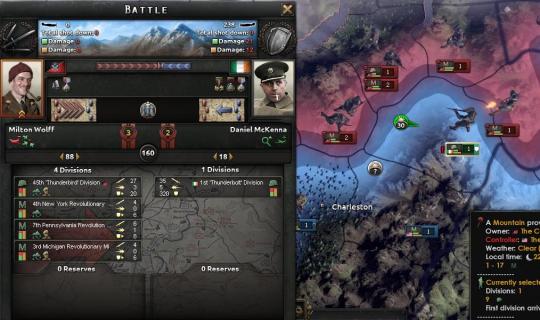
American militia units had stayed to defend the city, but McKenna had looked to secure the hills to the northeast. The Applachian plateau looked to give a good vantage point for artillery if any could succeed in the arduous task of towing them up to that position. Loyalist civilians had offered to do it on their own, pulling the units with their own work trucks, but that would be a dangerous undertaking without escort. McKenna took his Thunderbolts, with their own artillery pieces, to secure the hills first, while the militia guns could follow second when the way had been cleared. The Syndicates, tipped off by sympathetic informants, launched a massive push with their own 45th Thunderbirds, supplemented by local revolutionary forces, to prevent bombardment. The battle plan called for an overwhelming attack to break the dug-in mountain entrenchments, attacking from multiple directions in an attempt to dislodge the stubborn Irish defenders and find a weak spot.
McKenna demanded that the forces hold, using high-explosive burst shells over the heads of the enemy to maximize effect on the enemy. The engineers had dug in extensively, and had used dynamite to blast further fortifications and built entrenchments. The Thunderbolts only had a few guns, which were primarily pointed toward the northwest against the more highly-trained Thunderbirds. At such high elevation, and with such difficult terrain, evacuating casualties was difficult on the mountain, and men sometimes collapsed where they stood due to a combination of fatigue and high elevation.
That had been days ago, and the Thunderbolts were in tatters. The less wounded had even taken up shifts at night, or taking over service positions so able-bodied men could shoot and spot for the artillery. They had been holding, but just barely so. If it hadn’t been a mountain, they would have already been overrun. “I’ll be damned if I die on some cold rock half the world away from home.” McKenna defiantly continued to stand, hoping to wear down the superior numbers with artillery shells. He was the Wall of West Virginia, and he wouldn’t let the bastards through.
---
10 September 1937 - Pittsburgh, Pennsylvania
It had been months of hard fighting. Charleston had remained in Federal hands, and the front had stabilized, but all hopes of recovering the Federals in Kentucky were lost. The loyalists could only hope that the army groups had disbanded to make their way back to Federal territory in smaller numbers rather than being shot en masse, or worse, deserting to fall in with the enemy for their own salvation.
MacArthur had relied on the volunteers to fight a great deal of battles, more than he had preferred. The states under his control were tapped out for manpower resources, and if he started poaching from the factory floors for more able bodies he’d run out of supplies. Supply was irregular, especially for fuel, which he needed to keep the planes in the sky and the troops moving across the front. Olds and Tunner were able to airlift a lot of supplies, but demand always outstripped supply, and the more supplies he lifted the more danger there was for explosions in the cargo holds.
Ultimately, MacArthur decided that he needed to attack, to keep the pressure on the east so that the Syndicalists did not pull more men to prevent Eisenhower from marching toward Chicago from Kansas and the Dakotas. The Syndicates had been attacking south against the American Union State and fortifying out of New York City, and MacArthur had theorized that they would be weak in between those two strongpoints. The Brazilian and Argentine volunteers offered to push toward Philadelphia, with the hopes of breaking the regional command post and sending Syndicalist forces into disarray, while the Irish opted to push into Pittsburgh to seize the valuable steel mills and threaten a push into Ohio. The Mexican volunteers opted to remain in Virginia to help guard the line against the Longists; they had feared if the American Union State won, there may have been calls to expand further south to seize valuable oil and mining territories; fears of the Golden Circle expansion as it was dubbed in Mexico had been a hot button issue for the Mexican volunteers. If the Irish could secure Pittsburgh, that would give them control of the railroad junctions and the rivers, and allow MacArthur to bring in militia units to bring the territory under control with little fighting. With that, they could push further north toward Erie, splitting the Syndicalists and isolating them in New York. With Canada closing the border to the Combined Syndicates, even to the point of having the Royal Canadian Mounted Police arrest suspected border crossers and turning them over to the Federal government in Denver, that would render a similar fate to the lost Federals in Kentucky. MacArthur just hoped that his south could hold against the Firsters. Trading Virginia for Pennsylvania was not a winning proposition.
The B&O Line had been cut early, forcing McKenna and the Thunderbolts to march for most of the trip. Even in September, Pennsylvania was still hot, to help with water and the unfamiliar terrain McKenna had largely followed the Mononghaela river. To the east, he had Federal troops supplemented by Maryland militia moving north to take Harrisburg. McKenna force-marched his troops into Syndicate territory, hoping to secure a clear pathway along the rail lines for American repair crews to fix the B&O.
McKenna had been fortunate, western Pennsylvania had been defended by irregular militia units, poorly armed and lacking artillery support. In many cases, McKenna found that they didn’t have enough rifles for every man and only a few machine guns, some had taken to using shotguns better suited for partridge than men. When he was lucky, a few barrages from the field guns was enough to send them packing, but even without that, a dedicated attack usually was able to force back the disorganized units. A pity he didn’t have tanks, even a couple of old Weltkrieg landships would simply be able to drive to Pittsburgh unimpeded as long as it was gassed up.
The locals were fiercely divided. A few times McKenna had gone near towns, he had been welcomed and told where the Syndicates had kept their ammunition depot. Most of the time, however, the homes were ransacked, the supplies taken. Horror stories came to McKenna about “war syndicalism,” Reed’s name for the efforts taken to ensure his fighting men had the food they needed to fight. Sometimes it was the Combined Syndicates directly, but more often it seemed to be neighbors seizing on old grudges, summarily beating those they suspected of disloyalty and stealing their possessions, donating them to Reed as an act of solidarity. Worse still was what happened to those suspected of disloyalty. The Combined Syndicates offered a bounty on saboteurs and informants, and that had led to hastily-convened People’s Courts, serviced by hanging judges. Even so, there were plenty of people loyal to the Combined Syndicates, shouting their approval at finally destroying the brutal oppressors of Wall Street and their puppets in the Federal government. For a moment, McKenna thought of Ulster, and remembered everything he had heard 15 years before, and then he remembered the refugees from the British Isles after their revolution.
Pittsburgh had been hastily-fortified, with burned out hulks of cars blocking the bridges into town, forcing McKenna to navigate the crude fortifications with great care. The civilian population had largely huddled in buildings with boarded-up windows. The large buildings had been long ago hit by artillery fire or bombings from aircraft. Rail tunnels had been places of safety, McKenna’s scouts had found a few brave souls trading for various materials on picnic blankets. The mayor, who had thrown in his lot with the Syndicalists, had fled the city with the rest of the CSA, and they had thrown those city councilmen loyal to the Federal government into the Ohio. Coordination was largely infrequent, done by amateur radio. The civilians largely wanted to be left alone, out of the civil war, but the war had come to them despite their best wishes.
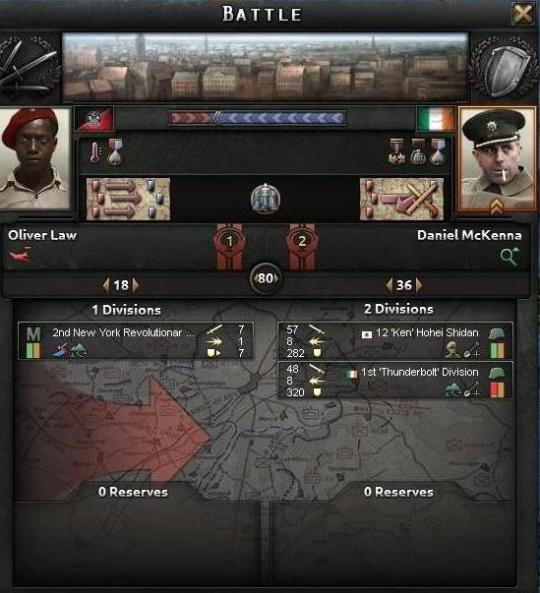
McKenna set to work, ordering his engineering corps to get the guns into firing positions. He positioned men near the Alleghany to prevent any CSA attack using the river to bypass his fortifications, and fortified the major exits with sandbags and machine guns. He had barely gone through half of his fortifications when he had heard the bad news: The Syndies were on the march along the Alleghany, and they would attack the city soon.
Yet, McKenna was not alone. The 12th Hohei Shidan, volunteer forces from far-off Japan, had come to support the Irish forces, and they had brought with them their Type 90’s, doubling McKenna’s supply of artillery. The Japanese and Irish soldiers met on the south side, and drew up plans for an attack. McKenna was given overall command, and elected to put his Irish veterans in the more dangerous forward position while the Japanese would fire on the CSA to draw them in under a battery of withering artillery fire. Once the enemy had descended past Lower Lincoln and could no longer enjoy visibility from Upper Lincoln, the Irish would ambush them in close quarters.

The CSA announced their attack with a radio command ordering all civilians to remain indoors, and all “foreign invaders” to surrender to the 2nd New York Revolutionary Guard, for handling by the legitimate United States government for repatriation. The 12th Hohei Shidan responded with a cannon barrage, thus commencing the Battle of Pittsburgh at 0900 on 10 September. McKenna’s Thunderbolts fought in ambush-and-retreat tactics, dividing themselves into seven-man fireteams. McKenna would fire on advancing CSA forces, retreat into a building, then have a second fireteam flank the New York Revolutionaries from across the street. Casualties were high on both sides, especially among the Irish who often refused to fight until in incredibly close combat, hoping the shock of the ambush would carry the day. Friendly fire incidents were high, especially as the day went into night, both from accidental fire on friendly troops and sympathetic civilians accidentally firing on who they believed were enemy soldiers. Yet the day stood. On 14 September, his squads battered and American troops pushing through central Pennsylvania, Oliver Law reluctantly ordered a retreat to the northeast. Western Pennsylvania stood liberated, but the war was not over yet.
---
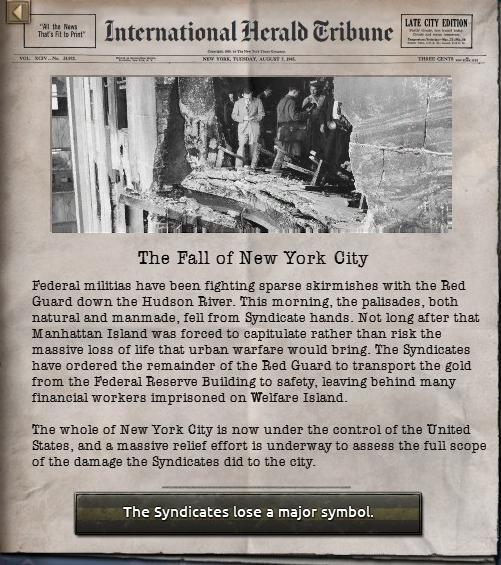
20 December 1937 - Welfare Island, New York City, United States of America
The icy winds of winter were howling, but the pit in Daniel McKenna’s stomach wasn’t from the cold. He had hoped to warm himself with a cigarette as he surveyed the successful conquest of New York City, but that had all left him. Naught but a short time ago, the celebration had been high. The Syndies had lost both a major symbol and, perhaps more pragmatically, their eastern command center. The Dominion of Canada had officially supported the Federal Government, and there had been Canadian, Indian, and French Republican volunteers sailing to Maryland to join MacArthur and the Volunteer Brigades, along with massive shipments of weapons from the Entente. Manhattan had surrendered rather than risk a massive urban brawl amongst the skyscrapers. That too, had seemed like a cause for celebration, but there was little sense of Christmas cheer among those who were picking through the ruins of New York City, for they had finally come to Welfare Island.
Inside, McKenna had found cell after cell of prisoners, skin stretched and hair falling out from starvation and malnutrition, their bodies broken from months of hard labor. When New York had fallen to the Syndicalists, they had imprisoned anyone who had worked in the financial sector, any who rented an apartment to another, or any who they considered to be bourgeoise, and demanded that they atone for the crimes of their previous lives with new, honest labor for the Syndicalist cause. They had been forced into the most dangerous jobs of the arms industry, like manufacturing artillery shells to the point where their skin had turned to a greasy yellow. Bleeding gums and fingers, limbs lost in machinery or explosive accidents were routine, each prisoner was a laundry list of atrocities written out upon their bodies.
Each horror that McKenna heard made him feel numb. He had nearly torn his gloves in two after listening, but he had made sure that he had heard it all, and that his staff heard it as well. A patriotic young woman, formerly a social columnist for the New York Tribune who had signed on to help with the support staff, volunteered to transcribe every word. “Be damned, lass, you’re a damn sight braver than any fella. Write it down, every bloody word, and know that ye’ve got a ironclad heart three times larger than any bastard who tells ye different.”
McKenna had dispatched three messages from New York. The first was to General MacArthur, who had said: “Am pleased to deliver to you New York as an early Christmas present.” The second was to Michael Collins, relaying a request for more reinforcement of men and materiel. The third, a private correspondence, bemoaned what he had seen. “The brutality of what I’ve seen is beyond words, and the only thing that breaks me more is the thought that this is not some singularly unique moment of malice, that we’ll find another Welfare Island in the South run by those America First bastards. God help me, is this what we left the English to in ‘25? Did we look at an Englishman for all those years and see the English and not the man?”
“Private. Bring all the Syndie prisoners we’ve got, make them see what went on here, make ‘em stare at each one. If they look away, hit ‘em. Then find the officers, and see which ones knew about it. And if ye find one that did...hang ‘em from the Brooklyn Bridge.”
---
Alright, that’s the second chapter, with the Syndicates on the ropes and the Firsters being slowly ground down in the western theater. The third chapter will handle the defeat of the Syndicalists and the Firsters and Mosley’s opening shots for his invasion of Ireland. Let me know what you think. And yes, I know some of the pictures are from 0.12, I’ve already mentioned that in my first post on the topic, and I know the battle map is crude; I suck at art. Also, what do you think about cropping the screenshots to make them easier to read? I think it looks fine, not too pixelated or zoomed in, but it does lose the sort of authentic “AAR screenshot” feeling. Which do you prefer, readers?
Images
Cactus Jack Becomes President
Standoff in America
Second American Civil War Begins
Battle of Baltimore
Encircled Federal Troops in Kentucky
US Moves the Capital to Denver
Germany Approves the Irish Business Initiative
Spain Approves the Irish Business Initiative
Italy Approves the Irish Business Initiative
The Netherlands Approves the Irish Business Initiative
The United States Approves the Irish Business Initiative
Canada Approves the Irish Business Initiative
Sweden Approves the Irish Business Initiative
Austria Approves the Irish Business Initiative
Rigged 1937 Election
The Wall of West Virigina
The Battle of Pittsburgh
Pittsburgh Battle Map
The Fall of New York
-SLAL
22 notes
·
View notes
Photo

E Coy ASU 3rd Batt Dublin Brigade, IRA, Grafton Street. 1921. (1024 x 535). Check this blog!
13 notes
·
View notes
Photo

“When being just a boy like you, I joined the IRA”
Maguire, member of the Irish Republican Army, sings the song, "The Boys of the Old Brigade" to Thomas before leaving the pub. At the time, Ireland was part of the United Kingdom although there was tension between the Irish Fenians and the United Kingdom. One big misconception is that everyone in Ireland hated the British. On Easter Sunday 1916, there was an uprising in Dublin and other parts of the country where members of the IRA who were fighting for the independence of Ireland, captured various places in Dublin, famously the post office, and declared the Irish nation free from British subjugation. The British took Irish captives, so the uprising was actually a failure. However, the harsh treatment of the Irish meant that the people in Ireland became very anti British. The Irish population became increasingly hostile and it's from that point on that the Irish war of independence starts: from January of 1919 until 1922. The IRA were fighting a guerrilla war against the British, especially against their Black and Tans, a pro-British paramilitary group in Ireland. The officer that Tommy has to shoot was a one of them. They were known for being incredibly ruthless towards the native Irish.
The whole island isn't part of one country, six northern counties remained part of the United Kingdom because the British monarchs planted English Scots and Welsh Protestants in the Northeast to subjugate the various Gallic resistance there. Which is why they were called Ulster and were Pro British and unionist.
In the in the second season of Peaky Blinders this becomes an issue because some of the IRA accepted the treaty that these six counties would go to the UK and some of them didn't. This was actually one of the main causes for the Irish Civil War which was right after the Irish earned their independence. The IRA started fighting among themselves of pro-treaty and anti-treaty.
image source: Wstnwl, peaky blinders fandom
#peakyblinders #netflix #bbc #stevenknight #shelby #peakyblindersofficial #byorderofthepeakyblinders #alfiesolomons #maycarlton #season2 #tommyshelby #arthurshelby #pollygray
Instragram
#peakyblinders#netflix#bbc#stevenknight#shelby#peakyblindersofficial#byorderofthepeakyblinders#alfiesolomons#maycarlton#season2#tommyshelby#arthurshelby#pollygray
1 note
·
View note
Text
#OTD in 1919 – Dan Breen and Seán Treacy rescue their comrade Seán Hogan from a Dublin-Cork train at Knocklong, Co Limerick; two policemen guarding him are killed.
In one of the most dramatic events in the Irish War of Independence, a handcuffed young Tipperary volunteer, Seán Hogan, was rescued from a train while sat between four armed members of the Royal Irish Constabulary (RIC). Two RIC were killed in the attack and a number of the volunteers wounded. The rescue was undertaken by three of Hogan’s comrades from the Third Tipperary Brigade of the IRA and…

View On WordPress
#"Big Four"#3rd Tipperary Brigade#3rd West Cork Flying Column#Co. Limerick#Danny Lacey#Dublin-Cork train#IRA East Limerick Brigade#Ireland#Irish History#Irish War of Independence#Jim Scanlon#Knocklong#RIC#Royal Irish Constabulary#Soloheadbeg Ambush
5 notes
·
View notes
Text
It Seems Like Nothing Changes
By Paul Cussen
October 1919
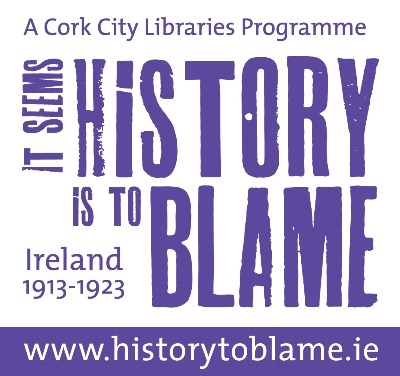
While Lloyd George’s government realise that Home Rule is not enough to satisfy the Irish, the Irish Committee of the British Government is recreated under heavy Unionist influence, notably through Sir Walter Long.
John McArdle, F Company, 1st Battalion, Dublin Brigade, Irish Volunteers loses the use of an eye during an exchange with British forces.
James Joyce leaves Zurich for Trieste. He writes to Harriet Weaver to say that he has found the manuscript of A Portrait… in the drawer of his desk, exactly where he had left it four years before. Not trusting the post-war postal system he divides the manuscript into four parts, posting each one separately, and promising that if any part did not arrive, he will write it out again for her.

(In July 1951 Harriet Weaver presented the manuscript to Frederick Boland as a donation for the National Library of Ireland. She was so impressed by Boland’s enthusiasm that she donated a portrait of the great man by Wyndham Lewis to the National Gallery of Ireland)
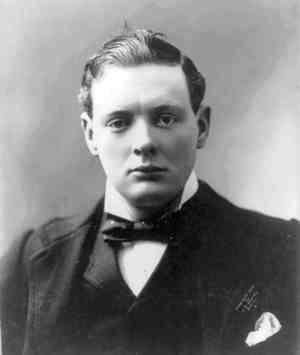
Winston Churchill condemns the IRA as ‘a gang of squalid murderers’ who have eluded capture.
D’Annunzio, the ‘John the Baptist of Fascism’, receives a cargo ship laden with military equipment. The Persia is captured by Giuseppe Giuletti and some volunteers who redirect it from its original destination of Vladivostock, where it is to supply the White Armies, to Fiume.
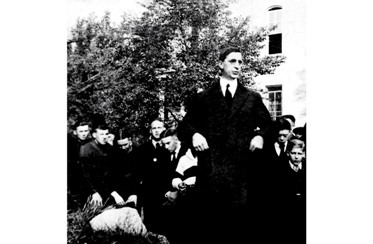
1-2 October
Dozens of doughboys shot at African-Americans and when police arrive they shoot at them during the Baltimore riot. Police reinforcements cause the soldiers to withdraw. In total six soldiers are arrested.
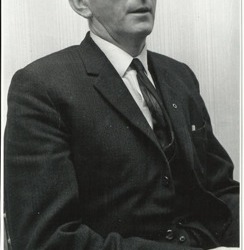
2 October
Seán 'ac Dhonncha is born in Carna, Connemara (d. 1996)
US President Woodrow Wilson has a stroke that leaves him partially paralysed.
3 October
John Boyd (Boyd Bradfield Upchurch) is born in Atlanta (d. 2013)
James M. Buchanan is born in Murfreesboro, Tennessee (d. 2013)

5 October
Private William Grenville dies of appendicitis in Cork.
Donald Pleasence is born in Worksop, Nottinghamshire (d. 1995)
5-6 October
61.6% of voters vote for prohibition (of spirits) in a referendum in Norway.

6-7 October
American marines and Haitian gendarmes repel an attack by Caco rebels under Charlemagne Masséna Péralte in the Battle of Port-au-Prince.
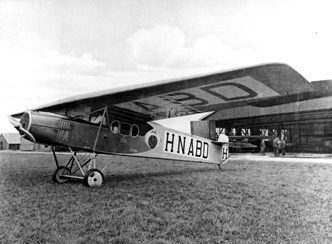
7 October
Koninklijke Luchtvaart Maatschappij N.V. (KLM) is founded and will become the first airline in the world to celebrate its centenary. The modified De Havilland DH-9B bomber pictured above was part of their London Amsterdam service with British Aerial Transport.
9 October
Constable Joseph Reynolds of the Dublin Metropolitan Police overpowers William Little who had just shot two “Asylum attendants and a private enquiry agent”.

10 October
Private W.J. Edwards dies of aenemia in Central Hospital, Cork aged 18.
11 October
Art Blakey is born in Pittsburgh, Pennsylvania (d. 1990)
11 Oct–18 Nov
Soviet forces halt the White forces advance on Moscow in the Orel-Kromy operation.
14 October
Aleksandar Stamboliyski is appointed Prime Minister of Bulgaria.

17 October
HMS Dragon is hit by two shells from a shore battery while taking part in an operation against German forces attacking Riga. Nine of the crew die and five are wounded.
RCA is created as a subsidiary to General Electric.

18 October
De Valera is made an honorary chief of the Chippewa in Wisconsin.
Pierre Trudeau is born in Montreal (d. 2000)
19 October
Detective Michael Downing of G Division (Dublin Metropolitan Police) is assassinated.
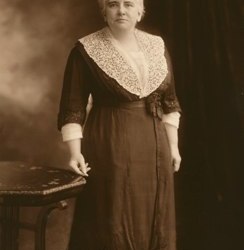
Anna Howard Shaw becomes the first female recipient of the US Distinguished Service Medal.
20 October
Ontario voters decide not to repeal prohibition in a referendum.
The man engine which transports miners underground at the Levant Mine in Cornwall fails. The rod which controls the movement breaks and men on the device plummet the 1,596-foot shaft. At least five of the 31 who die had served in the War.
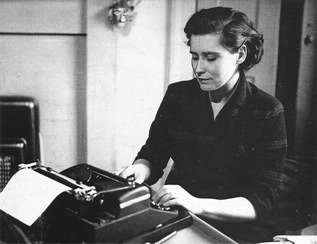
22 October
Doris Lessing is born in Kermanshah, Iran (d. 2013)
W. N. P. Barbellion (pen-name of Bruce Frederick Cummings), English naturalist and diarist, dies of multiple sclerosis (born 1889)
25 October
Jimmy Rudd is born in Dublin (d. 1985)
Six Republican prisoners (including Piaras Beaslaí) escape from Strangeways Prison.
Ireland and England draw 1-1 in front of a crowd of 30,000 in Windsor Park, Belfast.
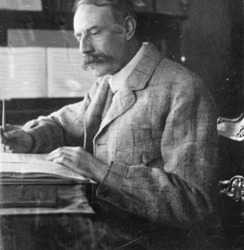
26 October
Edward Elgar’s Cello Concerto in E minor, Op. 85 premieres in Queen’s Hall, London.
President Wilson’s veto of the Prohibition Enforcement Bill is overridden.
27 October
James Joseph Magennis is born in Belfast (d. 1986)
Minister for Foreign Affairs, Count George Plunkett, reports ‘a steady progress’ in the development of Ireland’s foreign relations ‘in spite of all impediments’.
Mike Pepitone becomes the last victim of the Axeman of New Orleans.
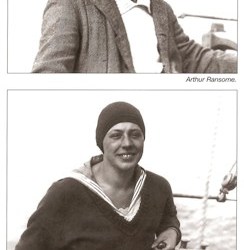
28 October
Arthur Ransome leaves Russia with his future wife Evgenia Petrovna Shelepina, who had been Trotsky's secretary.
30 October
Ella Wheeler Wilcox dies of cancer in Short Beach, Connecticut (b. 1850)
Laugh, and the world laughs with you;
Weep, and you weep alone.
For the sad old earth must borrow its mirth
But has trouble enough of its own
‘Since I went to Ireland the only party delivering inflammatory speeches inciting to the murder of the servants of the Crown has been the Sinn Fein party, and so long as these speeches are likely to be delivered by these men I will prohibit them.’
-Sir James Macpherson in the House of Commons
31 October
Two units of the IRA attack the RIC barracks in Ballivor, Co. Meath killing 35 year old RIC Constable William Agar and seizing a revolver, five rifles and a large amount of ammunition.
Elsewhere in Co. Meath, Sergeant Matthews and Constables Griffiths and O’Shea at Lismullin RIC barracks repel an attack by about 26 Volunteers.
3 notes
·
View notes
Photo

18th February 1920 Henry Timothy Quinlisk was shot as a spy by the IRA outside Cork city on 18th February 1920. Quinlisk was a Corporal in the Royal Irish Regiment, taken POW at Le Pilly in October 1914. His younger brother Michael was killed in the same action. Quinlisk joined Casement’s Irish Brigade in Limburg POW Camp in 1915 and was appointed a Quartermaster Sergeant. The Irish Brigade never amounted to anything as only 56 men volunteered to join. The plan had been to send them to Ireland to join the 1916 Rebellion. The men mostly spent their war in Berlin. After the war Quinlisk returned to Ireland, having been discharged from the Army. Oddly there doesn’t seem to have been any sanction imposed for their joining the enemy. Quinlisk also began using the alias Henry Quinn. He approached members of the IRA in Dublin and got into contact with Michael Collins, ostensibly offering to join the IRA but really looking for financial assistance, based on his membership of the Irish Brigade. Timothy received some money from Collins but blew it on gambling and further funds were not forthcoming. Quinlisk then turned coat again and offered his assistance to Dublin Castle to set up Collins for arrest. A raid in November 1919 on a house in Mountjoy Square, failed to net Collins because he had been tipped off by his double agents in the Castle. Quinlisk shortly moved to Cork where he was set up by a sting operation, fed the information that Collins was in Clonakilty, his homeplace. When the police raided Clonakilty, Quinlisk’s fate was sealed. He was lured to his death with the offer of money in return for showing the IRA how to operate a Hotchkiss machine gun. The unsuspecting Quinlisk accompanied his killers out of Cork and he was shot dead at a place called Tory Top Lane. The execution party consisted of Michael Murphy (O/C, 2nd Battalion, Cork No 1 Brigade), Frank Mahony (the Battalion Intelligence Officer) and Jimmy Walsh (a Captain in the same battalion). When his body was found, Quinlisk was not initially identified and he was buried in the workhouse burial ground in the city. A couple of weeks later his father, Denis turned up in Cork to claim his son’s body. Den https://www.instagram.com/p/CaIRhjFtQ5F/?utm_medium=tumblr
0 notes
Text
Remembering with pride the Dublin Brigade Irish Republican Army (IRA)

Dublin Brigade IRA – Patrick Cannon Dublin Brigade IRA – Tom Smith Dublin Brigade IRA – Ronan Mac Loughlin Dublin Brigade IRA – Alan Ryan & Vincent Ryan Dublin Brigade IRA – Martin Doherty.
View On WordPress
0 notes
Text
31 Historical Photos of the Irish War of Independence (1919-1921)
Group of women activists holding protest posters and an American flag, being directed by policemen, at an unidentified location, December 1920
The Irish War of Independence or Anglo-Irish War or the Tan War was a guerrilla war fought from 1919 to 1921 between the Irish Republican Army (IRA, the Army of the Irish Republic) and the British Security Forces in Ireland. It was an escalation of the Irish revolutionary period into armed conflict.
A truce was agreed in July 1921. In December 1921, the Anglo-Irish Treaty was signed, effectively ending British rule in Ireland, excepting the Six Counties: Antrim, Armagh, Down, Fermanagh, Derry/Londonderry, Tyrone.
Following the signing of the Anglo-Irish Treaty in December 1921, there was a steady evacuation of British soldiers from Ireland during 1922.
A historical photo set from National Library of Ireland that documented emotional moments of the Irish War of Independence (1919-1921).
The car in which Lord French was ambushed, sergeant pointing out bullet hole, Dublin, December 1919
A fraction of the thousands of people flocking each day to visit and pray at 'bleeding' statues set up in a yard beside T. Dwan's newsagents, Main Street, Templemore, Tipperary, August 1920
Aeroplane on roof at Barrack Street, Waterford, November 1920
Dublin and Cork fire brigade appliances, December 1920
Friends of the victims and members of the military outside Jervis Street Hospital during the military enquiry into the Bloody Sunday shootings at Croke Park, 21 November 1920
See more »
1 note
·
View note
Text
#OTD in 1902 – Birth of medical student and nationalist revolutionary, Kevin Barry, in Dublin.
Kevin Barry was 18 years old when he was hanged in Mountjoy Jail on 1 November 1920. His death at such a young age is possibly the most poignant in Irish history. He is one of a group of IRA members executed in 1920-21 collectively known as ‘The Forgotten Ten’.
Barry’s execution outraged nationalist public opinion in Ireland and its diaspora, largely because of his age. The timing of the…

View On WordPress
#Belvedere College#Carlow#Dublin#Dublin University#IRA#Kevin Barry#photo credit: 1916 Easter Revolution in Colour#Section Commander#The Dubliners#The Forgotten Ten#The Irish Brigade#The Wolfe Tones#War of Independence
6 notes
·
View notes
Text
Über Irlands Zukunft nach dem Brexit
Will man etwas über Irlands Zukunft nach dem Brexit aussagen, muss man zuerst über die irische Vergangenheit sprechen. Und kein Kapitel aus Irlands Vergangenheit ist zeitloser als das mit der IRA.
Will man aber etwas über die IRA aussagen, so muss man in erster Linie über South Armagh sprechen; aus dieser Region wurde die schlagkräftigste Brigade der ganzen Organisation rekrutiert, welche dreißig Jahre lang die spektakulärsten und erfolgreichsten Operationen gegen Großbritannien und ihre nordirischen Vasallen durchführte. So zumindest lauten die Begriffe aus IRA-Perspektive.

South Armagh
Die Region South Armagh ist ein Teil der nordirischen Grafschaft Down. Es handelt sich um eine 500 Quadratkilometer große Grenzregion westlich der nordirischen “Großstadt” Newry, in der ungefähr fünfzigtausend Menschen leben. Die Bevölkerungszahl von South Armagh ist etwas geringer; sie liegt um die vierzigtausend, die auf Dörfern über die Landkarte verteilt sind.
South Armagh wurde erst 1921 zum Grenzland, davor aber ist die Region bereits jahrhundertelang als “Bandit Country” berühmt-berüchtigt gewesen. Das Gebiet rund um Crossmaglen, Cullyhanna und Drumintee (um nur die “schlimmsten” Ortschaften zu benennen) haben mehr Gewalt als sonst ein Teil von ganz Irland produziert. Früher waren es die Ribbonmen,katholische arme Schlucker, die Vergeltungsaktionen gegen protestantische Landlords verübten, später ist es die IRA gewesen, die von der verschworenen Struktur der dörflichen Gemeinschaften profitierte. Gewaltsame Insubordination war in South Armagh schon immer ein generationenübergreifendes Familiengeschäft, wo Väter die Kunst der Gewalt in die Hände ihrer Kinder legten. Und daran hat sich bis heute nicht viel geändert, wenn man sich aktuelle Einschätzungen ansieht.
Die IRA genoss in South Armagh besonderes Ansehen. Ihre Kämpfer galten als Befreier und jedermann kannte sie. Sie waren lokale Berühmtheiten, und das sonst überall vorherrschende Problem des Verrats war kaum vorhanden, weil jeder die Familie des anderen kannte und alle irgendwie miteinander verwandt waren. Desweiteren zeigte man in den wenigen Fällen von Verrat keine Gnade in South Armagh; Verräter wurden bis nach Amerika verfolgt und noch im tiefsten Mittleren Westen hingerichtet - und ich beziehe mich hierbei nicht auf Geschehnisse aus der aktuelleren Neuzeit, sondern aus dem 19. Jahrhundert. Fakt ist: Menschen aus “God’s Country” verraten sich nicht, sondern schweigen und/oder helfen einander aus. Die Menschen vermeiden den Kontakt zu Polizeikräften, ebenso verweigern sie sich auch bis heute konsequent dem Eintritt in deren Reihen. Polizei und South Armagh sind zwei Begriffe, die nicht miteinander kompatibel sind.
Als Großbritannien in den 1970er Jahren 30.000 Soldaten nach Nordirland entsandte, wurde selbst von den Brits ein großer Bogen um die Region gemacht. Die ländlichen Straßen waren für jederart Uniformierten ein Spießrutenlauf, der regelmäßig tödlich endete: man wurde entweder mit Maschinengewehren beschossen, durch selbstgebaute Bomben und Mörsergranaten in die Luft gesprengt oder von Scharfschützen ins Korn genommen.
Helikopter wurden mit Raketen attackiert, Züge am hellichten Tag überfallen und Straßenkontrollen durch IRA-Einheiten durchgeführt. Vor Ort fand andauernd ein Katz- und Maus-Spiel zwischen Royal Ulster Constabulary, britischer Armee und IRA-Kämpfern statt. Und letztere zeigten sich in der Regel erfolgreich.
Die Briten versuchten der Situation durch noch größere Militärpräsenz, Bombenabwurf und verstärktem Einsatz von Spezialeinheiten Herr zu werden, aber all das brachte nichts. Bauern könnten zwischen zwei Kühen melken kurzerhand die Waffe ergreifen und vorbeifahrende Soldaten erschießen, um sich danach wieder so als ob niemals etwas geschehen wäre ihren Kühen zu widmen. Solcherart Kaltblütigkeit kann man kaum vorstellen, stellte aber Teil von South Armaghs Alltags dar.
Nirgendwo sind mehr britische Soldaten und nordirische Polizisten als im Großraum South Armagh gestorben, keine andere IRA-Einheit war erfindungsreicher, wirtschaftlich selbstständiger, in Guerillakriegsführung besser ausgebildet oder besser organisiert. Dabei besaßen viele der hiesigen Kommandanten keine abgeschlossene Schulausbildung. Sie hatten sich alles durch jahrzehntelanges probieren und hören auf die Ratschläge Älterer selbständig angeeignet, besaßen eigene Werte und zeigten nur selten Gnade.
Der inzwischen 65-jährige Chief of Staff und Schattenmann der South Armagh-Brigaden Thomas ‘Slab’ Murphy wurde einst gefragt, wie die IRA den Krieg gegen die Regierung gewinnen könnte. Dieser antwortete darauf: “We’ll bomb them to the consulting table and then we booby-trap the table.”
Das ist das IRA-Profil, über das wir im Zusammenhang mit dem Brexit sprechen müssen.
Die IRA hat 2007 verkündet, dass sie ihr Waffenarsenal unbrauchbar gemacht und den bewaffneten Kampf eingestellt hat. Meines Erachtens gilt diese Aussage bezüglich der South Armagh Brigade nicht. Die örtlichen Kämpfer werden mit Sicherheit ihre Waffen im Zuge der Abrüstung nicht abgegeben haben, und wenn, dann höchstens diejenigen, die sowieso bereits schrottreif waren. Auch die früher maßgebliche Rollen spielenden Familien leben weiterhin in der Gegend, sodass jeder gewaltsame Brexit-Widerstand von South Armagh aus seinen Anfang nehmen wird. Tradition verpflichtet.
Zu bedenken ist, dass die letzten zwanzig Jahre über die Waffen schwiegen. Allerdings schwiegen sie auf allen Seiten, und alle Kämpfer von damals sind langsam in die Jahre gekommen. Allerdings zeichnete sich schon während der “Troubles” die South Armagh Brigade dadurch aus, dass sie im Gegensatz zu anderen IRA-Einheiten bevorzugt ältere Kämpfer einsetzte. Trotzdem wird es einige Zeit dauern wird, bis junge Rekruten kampfbereit sind. Diese wurden in South Armagh im Gegensatz zum Rest des Landes schon füher nicht ins kalte Wasser geworfen, sondern langsam an das Kriegshandwerk herangeführt. Und man kann davon ausgehen, dass die Brigade seit der Brexit-Entscheidung 2016 nicht untätig gewesen sein wird: in der Kriegskunst gewinnt Weitsicht…
Irland
Die Südiren sind nur an ihrem Wohlstand interessiert. Dieser allerdings ist maßgeblich davon abhängig, ob es eine offene Grenze zu Großbritannien gibt. Die komplette Energieversorgung und der Handel wird über den mächtigen Nachbarn abgewickelt, und jeder Plan, zukünftig auf Routen in Richtung kontinentales Festland auszuweichen, ist utopisch: erstens fehlt die notwendige Infrastruktur, zweitens nimmt deren Aufbau mitsamt aller Planung, Genehmigung und Entwicklung sehr viel Zeit in Anspruch, und drittens würde solch ein Projekt auch dann noch höchst unwirtschaftlich bleiben, wenn man nur bedenkt, dass Liverpool gerade mal 160 km entfernt von der Irischen Insel liegt; und der Ire wählt von Natur aus den geringsten Widerstand.
Würden die Grenzen geschlossen werden, würden Import und Export schlagartig teurer werden. Das wiederum würde sich sofort in den lokalen Verbraucherpreise bemerkbar machen, die daraufhin durch die Decke gehen und den Standort Irland für ausländische Arbeitskräfte unattraktiv machen. Und von letzteren ist die Insel extrem abhängig.
Dublin hat also mit hinreichender Wahrscheinlichkeit kein Interesse an geschlossenen Grenzen. Sie müssen mit Großbritannien eine Lösung finden, jede andere Entscheidung läge zwischen dämlich und selbstmörderisch. Und letzteres sind die Südiren nicht..
Nordirland
Nordirland wiederum kann die Grenze nach Süden unmöglich schließen. Dafür fehlt es schlicht am notwendigen Grenzpersonal , um die vierhundert Kilometer lange Landesgrenze mit ihren unzähligen grenzüberschreitenden Straßen effektiv abzuriegeln. Das gelang noch nicht einmal damals, als dreißigtausend britische Soldaten zur Verfügung standen. Auch Hightech-Überwachung funktioniert nur unzulänglich, wie man weiß, wenn man entweder die Zuverlässigkeit von Technik oder auch nur ein wenig die Gegend kennt. Außerdem ein weiterer Punkt: für solch eine “Lösung” fehlt vorne und hinten das Geld. Denn Justiz und Sicherheit sind die einzigen Bereiche, wo überhaupt in Nordirland gespart werden kann - beide besitzen keine Lobby.
Die Regierung Nordirlands ist seit Jahren innenpolitisch handlungsunfähig. Sie ist in die einander im Gegensatz stehenden radikalen Flügel von Sinn Fein und UDP gespalten ist, die ausschließlich auf die Interessen der eigenen Wählerschaft fixiert ist.
Nordirlands Landeshaushalt ist vollkommen von britischer Subventionierung und EU-Beihilfen abhängig. Wales und Schottland klagen bereits seit Jahren darüber, wieviel Geld ins irische Armenhaus fließt und dass sie selber zu kurz kommen. Die diesbezüglichen Standardantworten aus London und Brüssel lauten: “Wahrung des Friedens durch Ermöglichung wirtschaftlicher Sicherheit”. Darüber hinaus sichern UDP-Stimmen die Regierungspolitik von Großbritanniens Regentin Theresa May ab.
Grenzbeamte aus dem Ärmel zaubern kann Nordirland nicht. Sie auch nur zu finanzieren gelingt ebensowenig. Bleibt also nur die britische Armee zur Unterstützung des Grenzschutz übrig. Und spätestens dann würde es in South Armagh wieder knallen, nämlich Sektkorken wie auch Schüsse. Dank der Grenze würde aufs neue der Schmuggel und damit die IRA aufblühen, weil sie nicht nur Geld kriegt, sondern der Brexit auch scharenweise Freiwillige anzieht, unter anderem auch wegen dem Geld: Osama Bin Ladens Al Qaeda hat letzteres eindrucksvoll vorgeführt, nachdem der Terrorpate Mitte der 1990er Jahre von der sudanesischen Regierung um sein Vermögen geprellt wurde - auf einen Schlag waren die meisten Kämpfer weg. Und islamistische Gotteskrieger sind mit Sicherheit weniger kapitalistisch als irische Pendler orientiert, die aufgrund einer wiederauferstandenen Grenze ihren bis dahin gut bezahlten Job im Süden verlieren und die dadurch gewonnene Freizeit mit ficken, saufen und streiten kompensieren müssen. Denn ein typisch irischer Charakterzug darf an dieser Stelle nicht vergessen werden: steht der Ire mit dem Rücken zur Wand, dann spielt er mit hohen Einsätzen. Denn entweder er gewinnt, ansonsten verliert er - und wenn's bleibt wie es ist, hat er sowieso verloren; die Richtigkeit dieser Aussage lässt sich an den Umsätzen irischer Wettbuden in Krisenzeiten minutiös ablesen.
Kommen also die Briten, kommt Bewegung ins Spiel und ein altbekanntes Kapitel fängt wieder von vorne an. Nur diesmal knallt es dann richtig: Irland und Nordirland sind Heimat für zigtausende Worker aus aller Herren Länder geworden. Diese sind es, die Gesamtirlands Wirtschaftswunder am laufen halten, und sobald in irgendwelchen Städten wieder Bomben fallen, rennen diese nach hause und die ganze Insel wird in einen wüsten Winterschlaf fallen. Denn kaum ein jugendlicher ExPat hat auch nur den Hauch einer Vorstellung davon, was ein städtischer Guerillakrieg ist.
Das kann sich niemand leisten.
Was bleibt also an Alternativen übrig, wenn Nordirland keinen eigenen Grenzschutz besitzt, von außen keine Hilfe holen und die Grenze selbst dann nicht abriegeln kann? Sich auf die Hilfe einer Republik Irland verlassen, die kein Interesse daran hat und deren eigenes Sicherheitspersonal im Zweifel immer Sympathien für die IRA aufbringt, und sei es nur deshalb, weil man nicht weiß, wer im Süden alles Teil davon ist und wen man zum eigenen Nachteil gegen sich aufbringt? Unwahrscheinlich.
Die katholischen Republikaner träumen so wie seit jeher mal wieder von einem vereinigten Irland, allerdings besitzen weder Dublin noch Belfast ein Interesse daran. Die Iren kommen schon mit ihrem jetzigen Staat kaum klar und werden sich mit Sicherheit keinen armen Bruder aufbürden wollen, der ihnen anstelle der Briten zukünftig auf der Tasche liegt. Stattdessen verhält man sich lieber ganz irisch und profitiert so wie die IRA von Nordirlands deutlich geringeren Preisen, was Produkte, Arbeitskraft und Lebenserhaltungskosten ganz allgemein betrifft.
Sonstiges
Ein EU-Austritt der Republik Irland ist ebenfalls undenkbar: die Republikaner auf beiden Seiten würden das als Rückschritt in Richtung britischen Kolonialismus betrachten und der alte Konflikt würde erneut aufflammen. Schon so ist die Situation angespannt genug, wenn man bedenkt, dass Belfast beispielsweise auch heute noch eine geteilte Stadt ist: Katholiken und Protestanten leben weiterhin in durch hohe Mauern mit Stacheldraht getrennten Stadtteilen, wohin die Verbindungstore morgens geöffnet und abends wieder verschlossen werden.
Eintracht sieht anders aus - selbst im Kader von 1860 München herrscht mehr Geschlossenheit. Oder weniger, sozusagen.
Conclusio
Dublin kann daher nur die Flucht nach vorne antreten und eine wirtschaftliche Sonderzone im Verbund mit Nordirland anstreben. Die Wege nach Großbritannien müssen frei zugänglich bleiben, der Warenhandel mit dem Empire darf keinesfalls eingeschränkt werden. Davon profitieren auch die Briten, die andernfalls das nordirische Armenhaus noch stärker finanzieren müssten. Und Irland liegt weit abseits der EU - wo, wenn nicht dort, kann man sich offene Grenzen erlauben?
Daher dürfte Dublin zum großen Gewinner des Brexits werden: aus anderer Richtung wird der Zugang in Richtung Ärmelkanal beschränkt, sodass die Republik Irland Europas einzig offenes Tor zu Großbritannien sein wird
Das heißt, dass sich noch mehr Unternehmen als heute bereits auf der Grünen Insel ansiedeln und Europas chaotischste Hauptstadt noch chaotischer wird. Der Dubliner Immobilienmarkt wird auch weiterhin verrückt spielen und im Dubliner Stadtzentrum wird man schon schon kein Pint Bier mehr unter acht Euro kriegen. Und unter dem Strich wird der Kampf um Arbeitskräfte noch bunter werden.
Es bleibt also alles beim alten - the luck of the Irish, halt.
0 notes
Text
It Seems Like Nothing Changes
Paul Cussen
June 1919

In June 1919 the Cork Furniture Store, which had moved from Merchant Street to a new premises on Winthrop Street, took over London House on Saint Patrick’s Street and expanded to sell ladies clothes. The firm was owned by William Roche from Killavullen.

The Ford building on the marina covered a floor area of 330,000 square feet, just over 7.5 acres. The company employed 1,800 workers. John O’Neill, who joined Ford in 1919 and later became Managing Director of the plant (in 1932), described the plant as being ‘ahead of anything else in Europe’ in terms of layout and equipment.
In late June the lease on the Cork National Shell Factory was taken over from the Corporation of Cork by Richard Woodhead, acting on behalf of the Ford Company. In the 1930s it was leased to the Lee Motor Company.
Cork hurlers changed from blue jerseys with a large saffron C across the chest after British forces raided the County Board offices in Cook Street and confiscate their kits.

In June 1919 Michael Collins was made president of the IRB (Irish Republician Brotherhood).
Terence MacSwiney led an abortive raid to gain arms and ammunition at the Killeagh air ship base, a facility of the Royal Naval Air Service.
The 2nd Battalion of the Royal Munster Fusiliers remained in France until June 1919 when they returned to England.
From January to June 198 British soldiers in Ireland died: 118 from influenza/pneumonia, 55 died from other natural causes, 6 died from firearms accidents, 15 from accidents not involving firearms and 4 from suicide.
Martin Doyle, originally from New Ross in Wexford, received his Victoria Cross from King George V at Buckingham Palace. In October 1920 he joined the IRA in East Clare acting as an intelligence officer.
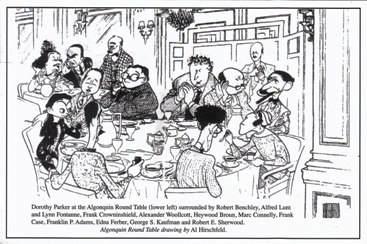
"The Vicious Circle" gathered at the Algonquin for the first time as the result of a practical joke carried out by theatrical press agent John Peter Toohey. It is only later, with their numbers growing, that they move to the now famous round table.

1 June
de Valera embarks on his tour of the USA with three aims:
· to ask for official recognition of the Irish Republic,
· to obtain a loan to finance the work of the new government, and
· to secure the support of the American people for the republic
2 June
New York City night watchman William Boehner is the only fatality as eight bombs detonate in eight cities across America. Each of the bombs is delivered with several copies of a pink flyer, titled "Plain Words", that read:
War, Class war, and you were the first to wage it under the cover of the powerful institutions you call order, in the darkness of your laws. There will have to be bloodshed; we will not dodge; there will have to be murder: we will kill, because it is necessary; there will have to be destruction; we will destroy to rid the world of your tyrannical institutions.
The bombings are carried out by Italian anarchist followers of Luigi Galleani.

3 June
Private Peter Asher dies of pneumonia at the military hospital in Buttevant.
Today’s Manchester Guardian review of Chekov’s The Seagull says:
“The Seagull” is a low-spirited play, and the sharpness of tragedy in it is blunted by Tchekov’s (sic) satire and irrelevances of other kinds. Tchekov, as we know from his stories, is a genial soul, and one missed somehow the feeling of sincerity in the climax to-day.
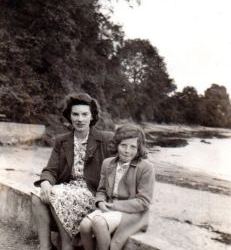
6 June
June Huband (who used the nom de plume Helen Forrester) is born in Hoylake on Merseyside (d.2011)
The United States Senate pass a resolution asking for the delegation appointed by Dáil Éireann to be given a hearing at the Paris Peace Conference, and expressing sympathy with the “aspirations of the Irish people for a government of their own choice”.
5-7 June
600-700 Armenian civilians are murdered by armed ethnic Azeri and Kurdish irregulars and Azerbaijani soldiers in the Khaibalikend massacre.

7 June
The Sette Giugno riots occur in Malta, as a crowd of thousands are shot at by British soldiers. Four die and over 50 are wounded in protests challenging the British presence on the island.
8 June
Constantine Fitzgibbon is born in The United States (d. 1983)
Coslett Herbert Waddell dies (b. 1858)
9 June
The City of Winnipeg Police Commission dismiss almost the entire city police force for refusing to sign a pledge promising to neither belong to a union nor participate in a sympathetic strike.
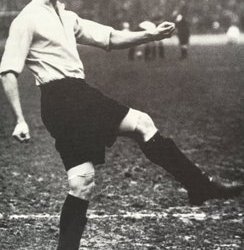
10 June
Kevin O’Flanagan is born in Dublin (d. 2006)
14 June
Walter Weedon Grossmith dies in London (b. 1854)

15 June
At 8.40 am after flying for 16 hours and 28 minutes and covering 1,900 miles without stopping, John Alcock and Arthur Brown mistook Derrigimlagh bog for a landing strip and landed their plane completing the first transatlantic flight.
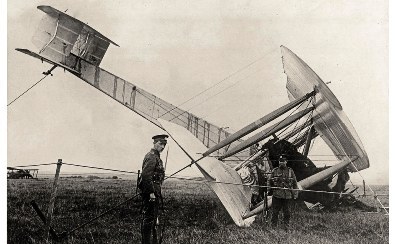
“I’m Alcock – just come from Newfoundland”, the Vimy pilot told the Marconi technicians that had tried to warn them about the bog.
“Yesterday, I was in America, and I’m the first man in Europe ever to say that.” – Arthur Brown
16 June
Fourteen IRA volunteers from the Kilbrittain company ambush a six-man British Army-RIC patrol at Rathclarin, Co. Cork and seize 5 rifles, one revolver and 200 rounds of ammunition. Only 2 of the IRA men are armed for the ambush. Volunteer Mick O’Neill is injured in the raid which was not sanctioned by Brigade HQ. "The fact that it was completely successful had an immense effect on morale and on the whole direction of the volunteer military effort in West Cork."
Greek forces lose 20 men in the Malgaç Raid as Turkish forces destroy the railway bridge and capture weapons and ammunition.
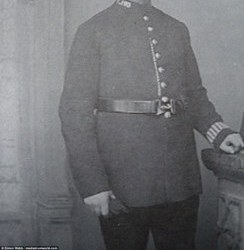
17 June
Station-Sergeant Thomas Green is wounded in the Epsom Riot when 400 Canadian troops attack the police station after two soldiers had been arrested.
18 June
The Dáil establishes the National Arbitration Courts.

19 June
The Dáil approves the First Dáil Loan (for £500,000)
20-21 June
Greek forces suffer 30-80 killed and 40 wounded in the Turkish raid on Erbeyli. 72 Turkish civilians are abducted and executed by Greek troops as a warning against future raids.
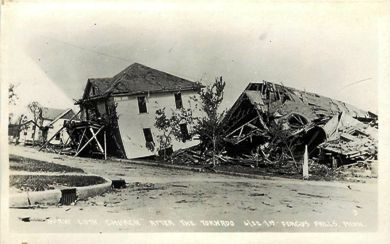
22 June
A tornado kills 57 people in Fergus Falls, Minnesota.
Greek units suffer 30 killed and 40 wounded in the Turkish raid on Erikli. This causes Greek forces to retreat.
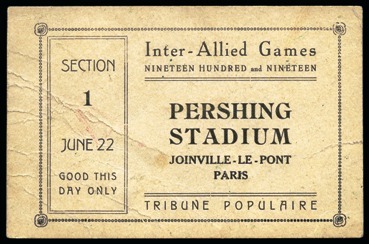
Approximately 1,500 servicemen or ex-sevicemen from 18 countries compete in the Inter-Allied Games in Le Stade Pershing outside of Paris.
23 June
RIC Detective D.I. Michael Hunt is shot twice in the back in a scuffle with IRA volunteers Jim Stapleton and James Murphy in Thurles, Co. Tipperary.
24 June
Two RIC officers are attacked and disarmed near Meenascarthy, Co. Kerry. Ten IRA volunteers are later arrested and five of them sentenced to gaol.
25 June
24 Americans are killed and 25 wounded repelling Red Army forces at the Battle of Romanovka. The Red army lose a similar number of men.
26 June
Castletownbere born William Martin Murphy dies in Dublin (b. 1845)

28 June
The Treaty of Versailles is signed in the Hall of Mirrors.
Two British soldiers are killed while on patrol by the Irish Republician Army.
Ion Dezideriu Sîrbu is born in Petrila (d. 1989)
29 June
Dáil Courts are established to hear civil cases.

Cork players wear red jerseys for the first time as they play against Tipperary in the Munster Hurling Semi-Final at the Cork Athletic Grounds in Ballintemple. The admission price is increased from sixpence to 1 shilling which results in protests that include sections of sheet iron being torn down at one end of the grounds. The result of the match is Cork 2-4 Tipperary 2-3.
1 note
·
View note
Photo

The Dublin City Brigade IRA paraded at Smithfield on April 2nd, 1922, "under officers who recognize the Executive established as a result of the recent Convention," according to the Irish Independent. They were addressed by Oscar Traynor [standing], Rory O'Connor and Frank Henderson.
1 note
·
View note
Text
Martin Savage : Ambush at Ashtown
Ireland 1919 and The War of Independence is in its opening stages. George V rules the United Kingdom of Great Britain and Ireland via his Prime Minister David Lloyd George. On the 28th June that summer the Treaty of Versailles had been signed and as the Great War closed the British Empire felt moderately assured that it’s oldest, closest and most rebellious colony would soon come to heel. But the insurrection had only begun. On January 21st of that year, with the tragedy and glory of Easter 1916 still haunting the islands collective consciousness, a renegade Dail Eireann met for the first time in the Mansion House in Dublin.
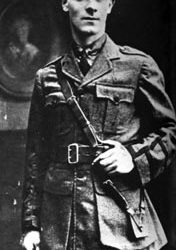
19th December 1919 Ashtown, a townland of Castleknock. An IRA volunteer column lead by Paddy Daly and consisted of Mick McDonnell, Tom Kehoe, Sean Tracey, Seamus Robinson, Sean Hogan, Vincent Byrne, Tom Kilkoyne, Joe Leonard, Dan Breen and Martin Savage plan an ambush on the highest authority of the British Crown in Ireland. Their target was the British Viceroy, Lord Lieutenant and Supreme Commander of the British Army in Ireland himself, Lord John French.
Savage was a volunteer officer in the 2nd Battalion Dublin Brigade of the IRA. The son of a Fenian activist he had originally chosen life as a grocer, his employer described the shy teen as "a steady, sober and industrious young man, gentlemanly in manner and extremely courteous.” However, he would find himself leaving civilian life behind and being caught in the crucible of the fight for Irish freedom. Having moved to Dublin from Sligo as a teenager he fought in the Rising at the tender age of 17. He was taken prisoner in Richmond Barracks and escaped execution by deportation to Cheshire in England where he was detained at Knutsford Barracks. On his release, he returned to the fight in Ireland obtaining the rank of Lieutenant.
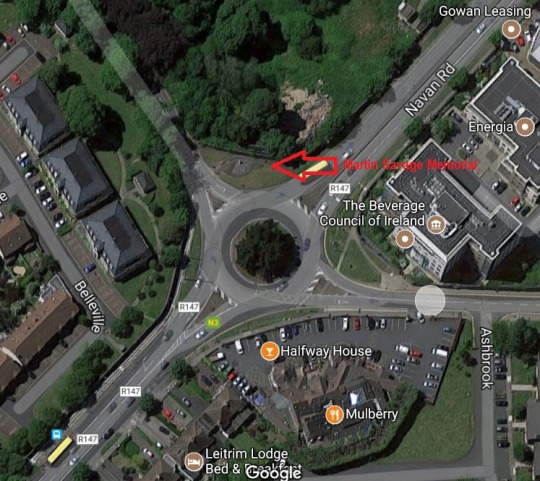
Attempts at tracking Lord French to a viable vulnerable ambush point had been frustrated for three months. Ashtown was chosen as French was scheduled to get off a train from Roscommon at the nearby station before being escorted in a two car convoy to the Vice-Regal Lodge in Phoenix Park. IRA intelligence reported that French usually occupied the second car in the armed convoy. It was a daring plan against considerable odds, however, the risk was considered worth it as killing the Viceroy would strike a huge blow against the British occupational forces and be a massive rallying call for the fledgeling Republic.
Breen formulated a plan where Martin Savage, Tom Kehoe and Dan Breen would partially obstruct the road with a cartful of hay at the crossroads where the Halfway House now stands, and where the Martin Savage memorial is located. When the first car had passed the cart the squad would completely block the road, signally the beginning of the attack on French in car two using Mills Bombs, a type of WW1 grenade. The volunteers had some revolvers and automatic pistols. They expected heavy resistance but a successful outcome would send shockwaves through the British Empire.
However on that faithful day luck would not be on their side. Synchronising with Frenches train arrival at 11:40 a.m., the volunteers left Kelly’s pub (The Halfway House) and took their ambush positions at the crossroads. Unexpectedly a Royal Irish Constabulary (RIC) officer appeared on the scene and spotted the men with the cart. He ordered them to stop. Thinking on their feet they threw a grenade at him. Although it didn’t detonate knocked the man unconscious and he was dragged off out of sight in to the undergrowth.
Critically, when the vehicles arrived disaster struck a second time that day as French had chosen to use the first car in the convoy. With French on the safe side of the blockade, when the IRA attacked the second car their quarry made his escape and the two RIC officers D/Sgt Halley and Constable O’Loughlin in the second car began to fire. The driver of the second car and volunteer Dan Breen were wounded in the initial exchanges of the fierce firefight, Breen taking a non-fatal hit to the leg. The volunteers regrouped under the hail of bullets. Savage positioned himself behind the hay cart and began to return fire with his automatic pistol. Alerted by car one, reinforcement British forces in another car swiftly arrived with rifles. Savage tried to throw a grenade at the newly arrived crown forces but as he broke cover Sgt. Rumbold saw his chance and fatally shot him through the neck. With his last words "I'm done, but carry on...." Savage died in the arms of his comrade Dan Breen. He was 21 years old.

Seen by many detractors at the time as a hopeless act of folly, the bravery of the attempt however doomed, demonstrated that the British had their weaknesses and hammered another nail in the coffin of imperial rule over Ireland. Savage`s sacrifice succeeded in helping catalyse a generation of Irish men and women to take up the cause of Irish independence. His memorial at the scene of the ambush, the roundabout at the old Phoenix Park racecourse and the Halfway house, was erected in 1948 by The National Graves Association at Ashtown Cross. Martin Savage’s remains were buried with full military honours in his native Ballisodare, Co. Sligo
0 notes